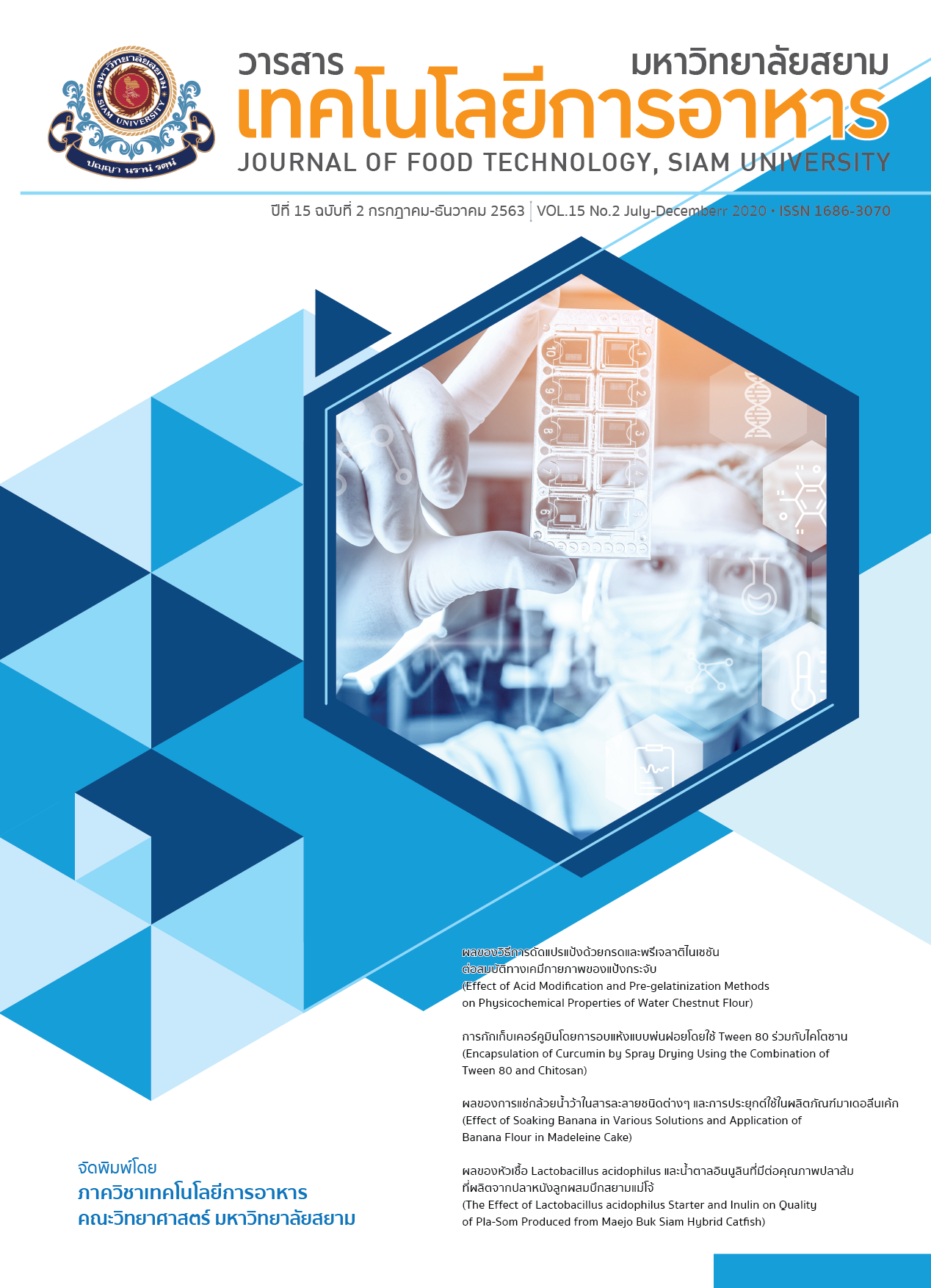The Effect of Lactobacillus acidophilus Starter and Inulin on Quality of Pla-Som Produced from Maejo Buk Siam Hybrid Catfish
Main Article Content
Abstract
Maejo Buk Siam hybrid catfish had been bred and farmed for commercial processing. However, fish belly is one of the major by-products obtained after fillet processing. Therefore, production of Pla-som with quality and prominence in term of functional properties from this part was subsequently initiated for value added. The aim of this study was to investigate the effect of supplementation by probiotic Lactobacillus acidophilus starter and prebiotic inulin on qualities of Pla-som. The 2x3 factorial experimental designs were used in this experiment. It was investigated that the appearance, color and salinity of all Pla-som treatments were not significantly different (p>0.05). However, Pla-som with high level of probiotic and prebiotic (1.0x109 CFU/100 g and 5% by wt. of inulin) possessed the highest viable cell of total lactic acid bacteria (7.11 log CFU/g), conform with its lowest pH value (4.57±0.01) and the superior total short chain fatty acids content (13.33±0.02 mg/g), which were significantly improved (p<0.05) comparing to those of indigenous fermented Pla-som. Moreover, this Pla-som (highest level of probiotic and prebiotic) obtained the highest acceptance score (p<0.05). Thus, there is a possibility to apply probiotic starter and prebiotic as ingredients in Pla-som fermentation to promote prominences of nutritional and functional properties and for commercial use.
Article Details
Copyrights of all articles in the Journal of Food Technology available in print or online are owned by Siam University and protected by law.
References
Swanson, D., Block, R. and Mousa, S.A. (2012). Omega-3 fatty acids EPA and DHA: health benefits throughout life. Advances in Nutrition. 3: 1-7.
Amornlerdpison, D., Mengamphan, K., Lailerd, N., Srimaroeng, C. and Suppahakitchanon, T. (2013). Developing and adding value of hybrid catfish (Black ear catfish x Pangasius) for increasing commercial productivity and increasing competitiveness: Complete research report. National research council of Thailand. (in Thai).
Mengamphan, K., Amornlerdpison, D., Tongsiri, S., Chitmanat, C., Wangcharoen, W. and Suppahakitchanon, T. (2012). Manual for culture of giant catfish, Pangasius and hybrid fish (Buk Siam) for added value and marketing (1st ed.). Chiang Mai: Maejo University Press, (in Thai).
Helland, M.H., Wicklund, T. and Narvhus, J.A. (2014). Growth and metabolism of selected strains of probiotic bacteria in maize porridge with added malted barley. International Journal of Food Microbiology. 91(3): 305-313.
Parvez, S., Malik, K.A., Ah Kang, S. and Kim, H.Y. (2016). Probiotics and their fermented food products are beneficial for health. Journal of Applied Microbiology. 100(6): 1171-1185.
FAO/WHO Expert Consultation Group. (2007). Health and nutritional properties of probiotics in food including powder milk with live lactic acid bacteria. Geneva: WHO.
Gibson, G.R., Robert, H.M., Loo, J.V., Rastall, R.A. and Roberfroid, M.B. (2004). Dietary modulation of the human colonic microbiota: updating the concept of prebiotics. Nutrition Research Reviews. 17(2): 259-275.
Pongtrakul, N., Rodboonrit, T., Popluechai, S., Niamsup, P., Deejing, S. and Wongputtisin, P. (2008). Effect of probiotic form on properties of milk ice cream. Journal of Food Technology, Siam University. 13(1): 58-70. (in Thai).
Wongputtisin, P., Ramaraj, R., Unpaprom, Y., Kawaree, R. and Pongtrakul, N. (2015). Raffinose family oligosaccharides in seed of Glycine max cv. Chiang Mai60 and potential source of prebiotic substances. International Journal of Food Science and Technology. 50(8): 1750-1756.
Pongtrakul, N. (2017). Development of synbiotic powder entrapped with Thai rice starch and Thai soybean oligosaccharides. Master thesis, Thailand: Maejo University. (in Thai).
Thai Industrial Standards Institute. Thai community product standard: fermented fish, Pla-som. [Online] Available from http://tcps.tisi.go.th/pub/tcps0026_57(%E0%B8%9B%E0%B8%A5%E0%B8%B2%E0%B8%AA%E0%B9%89%E0%B8%A1).pdf [Accessed September, 8, 2020]. (in Thai).
Kandler, O. (1983). Carbohydrate metabolism in lactic acid bacteria. Antonie Van Leeuwenhoek. 49(3): 209–224.
Paludan-Müller, C., Madsen, M., Sophanodora, P., Gram, L. and Moller, R.L. (2002). Fermentation and microflora of plaa-som, a Thai fermented fish product prepared with different salt concentrations. International Journal of Food Microbiology. 73(1): 61–70.
Owens, J.D. and Mendoza, L.S. (1985). Enzymatically hydrolysed and bacterially fermented sherry products. Journal of Food Technology. 20: 273–293.
Visessanguan, W., Benjakul, S., Smitinont, T., Kittikun, C., Thepkasikul, P. and Panya, A. (2006). Changes in microbiological, biochemical and physico-chemical properties of Nham inoculated with different inoculum levels of Lactobacillus curvatus. LWT-Food Science and Technology. 39(7): 814–826.
Bikila, W. (2015). Lactic acid bacteria: benefits, selection criteria and probiotic potential in fermented food. Journal of Probiotics & Health. 3(2): 1-9.
Schönfeld, P. and Wojtczak, L. (2016). Short-and medium-chain fatty acids in energy metabolism: the cellular perspective. Journal of Lipid Research. 57(6): 943-954.
Kopermsub, P. and Yunchalard, S. (2008). Safety control indices for plaa-som, a Thai fermented fish product. African Journal of Microbiology Research. 2(2): 18–25.
Parada Venegas, D., De la Fuente, M.K., Landskron, G., Gonzalez, M.J., Quera, R., Dijkstra, G., Harmsen, H.J.M., Faber, K.N. and Hermoso, M.A. (2019). Short chain fatty acids (SCFAs)-mediated gut epithelial and immune regulation and its relevance for inflammatory bowel diseases. Frontiers in Immunology. 10(16): 277.
Lamkampang, P. (2016). Effect of salt on fermentation and sensory characteristics of Kung-Jom. The Journal of King Mongkut's University of Technology North Bangkok. 26(1): 105-112. (in Thai).
Chaisakdanugull, Y., Phrikanahok, N. and Jaturapahu, U. (2012). Surveillance of Salmonellosis in livestock products imported into Thailand. Bureau of disease control and veterinary services. (in Thai).
Namwong, S. (2010). Potential of halotolerant and moderate halophilic bacteria for biotechnology. Burapha Science Journal. 15(2): 122-132. (in Thai).
Phithakpol, B., Varanyanond, W., Reungmaneepaitoon, S. and Wood, H. (1995). The traditional fermented foods of Thailand. ASEAN Food Handling Bureau, Kuala Lumpur, Malaysia. 6-9.


